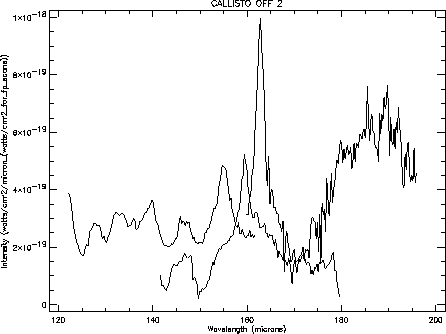Straylight features on the long wavelength detectors of LWS
Introduction
During the careful analysis of an LWS spectrum, one of the LWS consortium members found strange emission features on the longest wavelength detectors (LW3, LW4 and LW5), that were very similar to previously found features on shorter wavelength detectors due to a NIR leak (see note on the web dated 31 January 1997). A more thorough investigation by the LWS Instrument Team led to the discovery of about 46 cases to date. The features are only detectable in L01 spectra, since the wavelength ranges covered in L02 and L04 spectra are too small to be able to distinguish these features. For L03 data the current data processing is not in a state where a clear statement on the presence or absence of these features can be made.
The Feature
The straylight features manifest themselves as broad (few micron) emission peaks at 155 micron on detector LW3, 159 micron on detector LW4, and 163 micron on detector LW5. Furthermore a rise in flux can be seen on the LW5 detector longward of 180 micron. The features are visible only on rather faint sources (typically less than a few 10^-18 W/cm2 um at 160 micron), since the peak strength of the features is a few times 10^-19 W/cm2 um. An example of a spectrum with the features is shown in Figure 1. The biggest problem of these features is that the one on the LW4 detector blends with the 157 micron [C II] line. An possible additional component of straylight has been seen in a calibration source where an increase in the continuum flux level is observed in an observation with features with respect to other observations without the features. This however needs further checks on other calibration sources.

Figure 1: The straylight features on LWS detectors LW3 (155 micron), LW4
(159 micron) and LW5 (163 micron). Note also the strong rise in flux
beyond 180 micron. (Click here for figure x2)
Cause of the straylight.
An investigation was made to possible correlations between the occurance of the features and other spacecraft and instrument parameters such as temperatures, solar aspect angle etc., in order to try to find the cause of the straylight. Only one correlation could be found upto now. All observations of sources with low fluxes in LW3, LW4, and LW5 that have a dark current much higher than nominal (more than about a factor 2 times the nominal dark current), show the features. However, some observations that show the features show a perfectly nominal dark current. So clearly the relation is not perfect. No other correlation could be found, and thus the cause of these straylight features remains unclear. The LWS Instrument Team is now checking all observations with high dark current values for the features. Up to now a total of 271 spectra has been checked.
Further steps.
All observations that have been found by the LWS Instrument Team to be affected by the straylight features have been recommended for rescheduling. Given that the expected end of ISO's lifetime is close, there may not be sufficient time left to re-execute all the effected observations. The LWS Team will continue the investigations to find a possible cause for these straylight features, and will also try to find ways to correct spectra that show the features. When additional information is available it will be posted on this web page.LWS Instrument Team and ISO Science Operations Team.